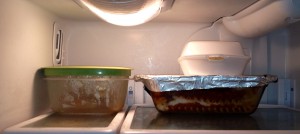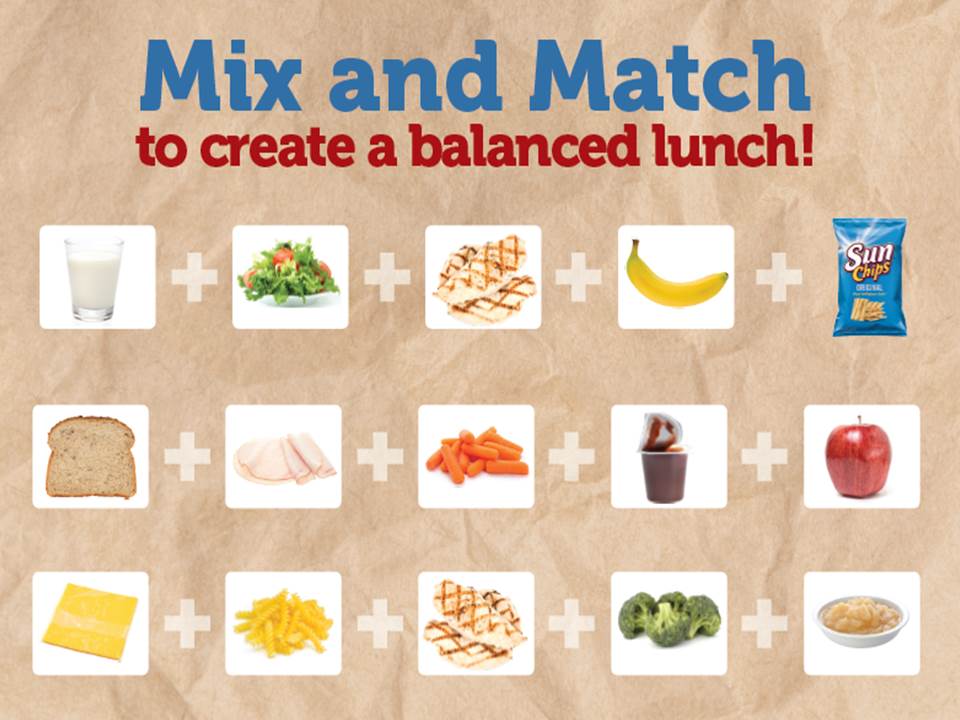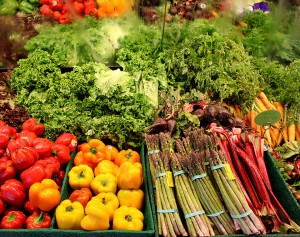
by Ricki McWilliams | Dec 11, 2014
 Being sick during the holiday season is no fun. Did you know the flu is not the only thing that can have you feeling under the weather? The Centers for Disease Control and Prevention (CDC) estimate that each year roughly 1 in 6 Americans (or 48 million people) get sick, 128,000 are hospitalized, and 3,000 die of foodborne diseases (CDC, 2014). This holiday season, UF/IFAS Extension Agents will be available to help keep you and the ones you care about safe by reminding you of the United States Department of Agriculture ‘s four steps to safer food handling this holiday season:
Being sick during the holiday season is no fun. Did you know the flu is not the only thing that can have you feeling under the weather? The Centers for Disease Control and Prevention (CDC) estimate that each year roughly 1 in 6 Americans (or 48 million people) get sick, 128,000 are hospitalized, and 3,000 die of foodborne diseases (CDC, 2014). This holiday season, UF/IFAS Extension Agents will be available to help keep you and the ones you care about safe by reminding you of the United States Department of Agriculture ‘s four steps to safer food handling this holiday season:
- Wash your hands and your cooking surfaces before you start, when you will touch different foods, and after you finish preparing a dish.
- Separate cooked foods and ready-to-eat foods from foods that still need to be prepared.
- Always cook and reheat your foods to above 140 degrees Fahrenheit.
- Chill your leftovers. Don’t let your dishes sit out without refrigerating or keeping them heated. Throw out foods that have been between 40 degrees and 140 degrees Fahrenheit for more than 2 hours.
Have a question that is not related to food safety, like:
- How do I make a brine for my turkey?
- I ran out of eggs – is there a substitute?
- I couldn’t find any buttermilk. What do I do?
…Don’t worry – call the UF/IFAS Extension Northwest District Family and Consumer Sciences (FCS) HOLIDAY FOOD HOTLINE. Northwest District FCS agents will be available 8am – 8pm CST/9 am – 9pm EST by calling 850-888-2412 (December 15 – January 1) to assist you with food preparation, food safety, or any other kitchen concerns you may have.
The best part is you can always count on UF/IFAS Extension to provide you with research-based information!
Holiday Food Hotline
850-888-2412
References:
Centers for Disease Control and Prevention (2014). “Estimates of Foodborne Illness in the United States” retrieved December 11, 2014 from http://www.cdc.gov/foodborneburden/
United States Department of Agriculture (2014). “Check Your Steps: Food Safe Families” retrieved December 11, 2014 from http://www.fsis.usda.gov/wps/portal/fsis/topics/food-safety-education/featured-campaign
by Judy Corbus | Nov 21, 2014
 Do you have food containers growing green fuzzies in the back of your refrigerator? It’s easy for leftovers and other food items to overstay their welcome in the fridge, creating a food safety hazard as well as unnecessary clutter. With Thanksgiving and the start of the holiday season just around the corner, now is the perfect time to super-clean your refrigerator. Follow these tips to get your refrigerator ready for Thanksgiving leftovers and other holiday treats:
Do you have food containers growing green fuzzies in the back of your refrigerator? It’s easy for leftovers and other food items to overstay their welcome in the fridge, creating a food safety hazard as well as unnecessary clutter. With Thanksgiving and the start of the holiday season just around the corner, now is the perfect time to super-clean your refrigerator. Follow these tips to get your refrigerator ready for Thanksgiving leftovers and other holiday treats:
- Remove everything from the refrigerator.
- Examine each container – discard outdated leftovers and any items of whose age you are uncertain or you don’t plan to use in the near future.
- Remove shelves, drawers, and bins. Wash with a solution of baking soda and warm (not hot) water.
- Clean the interior of the refrigerator with baking soda and warm water. Dishwashing detergent can leave a residue that can lead to odors if not rinsed thoroughly. Dry with a soft cloth or paper towel.
- Clean each container before returning it to the refrigerator.
- Wash the outside of the refrigerator with sudsy water (using hand dishwashing detergent), rinse, and dry. Wash the gaskets around the refrigerator doors – sticky gaskets can cause air leaks, costing you more energy over time.
- Vacuum the dust off the condenser coils, usually on the back of the refrigerator, or under it. Dirty, dusty coils make the refrigerator work harder to cool and use more energy, costing you more money.
- Remove and clean the “pan” or plastic tray at the very bottom of the refrigerator that collects the condensation or defrost water. Look in your care manual to find where this “pan” is located. Dust and moisture in this “pan” can cause mold to grow, causing health problems for people with allergies.
- Clean the floor around and underneath the refrigerator.
Your fridge is now ready for the holidays!
Sources: My Florida Home Book – Taking Care of Your Home, Chapter 5. Taking Care of Indoor Features, University of Florida/IFAS Extension, 2008.
http://www.cooksinfo.com/clean-out-your-refrigerator-day
by Ricki McWilliams | Nov 13, 2014
 There is a time limit on leftovers.
There is a time limit on leftovers.
While leftovers can be a lifesaver for figuring out lunch the next day or dinner when you’re in a time crunch, it is important to remember safe food handling practices including eating, freezing or tossing out refrigerated leftovers within 3-4 days.
Limits to leftovers
Put leftovers in the refrigerator as soon as possible; make sure your refrigerator temperature is 40o F or colder. When possible, label your leftovers with a date and eat within 4 days. If you want to enjoy your leftovers longer than 4 days, transfer them to the freezer. TIP: When placing hot foods directly in the refrigerator, separate the food into small, shallow containers. This allows the food to cool more quickly.
Storage for Leftover Foods – Best Quality
| Product |
Refrigerator (40o F) |
Freezer (0o F) |
| Eggs: |
| Casserole, quiche, omelet |
3-4 days |
2 months |
| Hard-cooked |
1 weeks |
Do not freeze |
| Soups & Stews: |
| Vegetables |
3-4 days |
2-3 months |
| Meat added |
1-2 days |
2-3 months |
| Meat Leftovers: |
| Cooked meat & meat dishes |
3-4 days |
2-3 months |
| Gravy & meat broth |
1-2 days |
2-3 months |
| Cooked Poultry |
| Fried Chicken, plain pieces, cooked poultry dishes |
3-4 days |
4 months |
| Pieces, with broth/gravy |
1-2 days |
6 months |
| Chicken nuggets, patties |
1-2 days |
1-3 months |
| Cooked Seafood: |
| Fish |
3-4 days |
3 months |
| Crab |
1-2 days |
3 months |
| Shrimp |
3-4 days |
2 months |
Fight Bacteria
Follow these four safe food handling practices to keep your foods safe from bacteria:
- Clean: Wash surfaces and hands before and after handling food products.
- Separate: Keep foods separate and don’t cross-contaminate.
- Cook: Cook and reheat food to at least 165o F (gravy, soups, and sauces should be reheated to a boil). Measure temperatures with a food thermometer.
- Chill: Bacteria grow quickly between 41o F and 140o F. Keep your food out of the danger zone by refrigerating it promptly.
For additional food safety information, contact your local UF/IFAS Extension Faculty member in your area.
Sources:
Partnership for Food Safety Education. www.fightbac.org
USDA Food Safety and Inspection Service. August 2013. Basics for Handling Food Safely. http://www.fsis.usda.gov/wps/portal/fsis/topics/food-safety-education/get-answers/food-safety-fact-sheets/safe-food-handling/basics-for-handling-food-safely/

by Ricki McWilliams | Sep 6, 2014
 It’s time to start getting backpacks ready, lunches packed and kids off to school. Back to school time is the perfect time to start packing a healthier lunchbox. Packing your child’s lunch may contribute to the difficulties of getting out the door in the morning but it does not have to. You know your child better than anyone, their likes and dislikes, so go with what you know.
It’s time to start getting backpacks ready, lunches packed and kids off to school. Back to school time is the perfect time to start packing a healthier lunchbox. Packing your child’s lunch may contribute to the difficulties of getting out the door in the morning but it does not have to. You know your child better than anyone, their likes and dislikes, so go with what you know.
The first step to packing a lunch is to determine how much food is enough for your child. You will know you did not pack enough when they come home and tell you they ate all their food and are still hungry. Likewise, if you pack too much, you will know by seeing uneaten or half-eaten items in their lunch box at the end of the day. Start by packing between 3 and 6 items. They will have enough variety in their lunch box to sustain them throughout the school day without too much waste. MyPlate.gov is a great resource for building a balanced meal (protein, vegetable, fruit, grain, dairy).
Secondly, pack as much as you can the night before. This will decrease morning stress. Cut up fruits and vegetables and store in an airtight container in the refrigerator. Cut up fresh ingredients for sandwiches, if required. Make up cracker or dried fruit packs. Wrap up home-baked treats and place in the lunch box.
Lastly, keep in mind this food safety tip: Include gel ice packs to keep refrigerated food cold. Refrigerated food shouldn’t be above 40 degrees for more than 4 hours due to increased bacterial growth causing possible illness.
Lunchbox Meal Ideas:
1.) Wheat crackers, cheese cubes, deli meat, strawberries/blueberries, snap peas (with their favorite dipping sauce*)
2.) Mini quiche, carrots, celery with peanut butter and raisins, whole fruit (pear, orange, banana)
*Want something to dip kid-friendly veggies in besides ranch? Try low-fat Greek yogurt, hummus, or this cottage cheese veggie dip:
1/2 cup low-fat cottage cheese
1/4 teaspoon lemon pepper
Enjoy with baby carrots, snow/snap peas, bell pepper strips
Snack Ideas:
1.) Whole wheat pita cut into wedges with 2 tablespoons hummus for dip
2.) Trail mix: mix 20 almonds, miniature box of raisins, and ¼ cup sunflower seeds
For additional information on creating nutritious meals, contact your local Extension office.
by Angela Hinkle | Jul 1, 2014
A picnic is a pleasure excursion for all ages, a delightful expedition away from the normal day. Whether at a park, at the beach, right outside under a tree, on the porch, or on the living room floor, picnics are a great way to slow down and enjoy.
Try some of these ideas for a little something different.
- For a night time picnic, make a pizza and some popcorn inside and take them outside for movie night. Use a projector to shine your favorite movie on a white sheet that you’ve hung up on the side of the house or a shed.

Enjoy a healthy and safe picnic this summer!
- Pack sandwiches cut in your favorite characters and shapes using cookie cutters.
- Make Ka-bobs. Put veggies, fruits, bread cubes, and chilled cheeses and meats on purchased wooden sticks or skewers. Making them is as much fun as eating them.
For food safety:
Keep cold foods cold. Plan to use well insulated coolers with plenty of ice. Don’t let cold foods sit out for more than one hour outside or two hours inside. Leftovers should be put back in coolers right after serving. The longer foods stay at unsafe temperatures, the more bad bacteria can grow and cause a foodborne illness.
Keep hot foods hot. Don’t let hot foods sit out for more than one hour. Plan to eat prepared foods shortly after they are cooked.
When it’s a rainy day or you just want the cool of air conditioning (or even something a bit warmer if its winter), take the picnic inside.
- Bring all the stuffed animals so everyone gets to come to the picnic. The more the merrier.
- Build a fort with blankets and a coffee table or if you have room, put up a tent on the living room floor for your picnic.
- Use chopsticks to eat peanut butter or other “sushi” rolls. To make this, smear peanut butter or low-fat cream cheese on a whole-wheat tortilla, put a banana in the middle, roll it up and sprinkle with cinnamon and raisins. Cut into slices. Ta da – Peanut Butter Sushi.
- For a romantic date night, pack a loaf of crusty bread, some Brie cheese, strawberries, whipped cream, and a bottle of something bubbly. Take cloth napkins and a comfy blanket to sit on.
Inside or outside – have a great picnic season!
by Heidi Copeland | Mar 3, 2014

Handle food safely and stay informed about food recalls.
Have you paid attention to any of the recent food recalls? In February 2014, both the U.S. Food and Drug Administration (FDA) and the U. S. Department of Agriculture (USDA) issued consumer food recalls and alerts for a variety of food safety reasons. Product recalls warned consumers about undeclared allergens, false or misleading labeling, pathogenic contamination, and unsanitary processing conditions, to name only a few of the reasons.
A safe food supply is important to everyone! Both the USDA and the FDA have responsibility for protecting different segments of the food supply however; there are other food safety agencies involved. Consumers play an important part in keeping food safe. In addition, to handling food safely, consumers need to be aware of food recalls. Watch for food recall notices in the news, at your local grocery store, and online at www.recalls.gov. If identifying marks on the food product you have purchased match the detailed information in the recall notices, then you can do the following:
- Return the product to the place of purchase for a refund. OR Dispose of the product following the instructions provided in the recall notice to assure it will not be consumed by anyone.
- Do not eat the product.
- Dispose of the product carefully.
- Do not give the product to others (do not give to food bank, your pet, for example).
- Do not puncture or otherwise open cans.
- Wash hands with warm water and soap for at least 20 seconds after handling the product.
The Bottom Line is… if you sense there’s a problem with any food product, don’t consume it. “When in doubt, throw it out!”
Share this educational information with family, friends, and neighbors. Stay informed, stay safe; check for product recalls.
View the following UF/IFAS Extension publications for more information about food regulation”
http://edis.ifas.ufl.edu/pdffiles/FS/FS12100.pdf
http://edis.ifas.ufl.edu/pdffiles/FS/FS11800.pdf

 Being sick during the holiday season is no fun. Did you know the flu is not the only thing that can have you feeling under the weather? The Centers for Disease Control and Prevention (CDC) estimate that each year roughly 1 in 6 Americans (or 48 million people) get sick, 128,000 are hospitalized, and 3,000 die of foodborne diseases (CDC, 2014). This holiday season, UF/IFAS Extension Agents will be available to help keep you and the ones you care about safe by reminding you of the United States Department of Agriculture ‘s four steps to safer food handling this holiday season:
Being sick during the holiday season is no fun. Did you know the flu is not the only thing that can have you feeling under the weather? The Centers for Disease Control and Prevention (CDC) estimate that each year roughly 1 in 6 Americans (or 48 million people) get sick, 128,000 are hospitalized, and 3,000 die of foodborne diseases (CDC, 2014). This holiday season, UF/IFAS Extension Agents will be available to help keep you and the ones you care about safe by reminding you of the United States Department of Agriculture ‘s four steps to safer food handling this holiday season:





